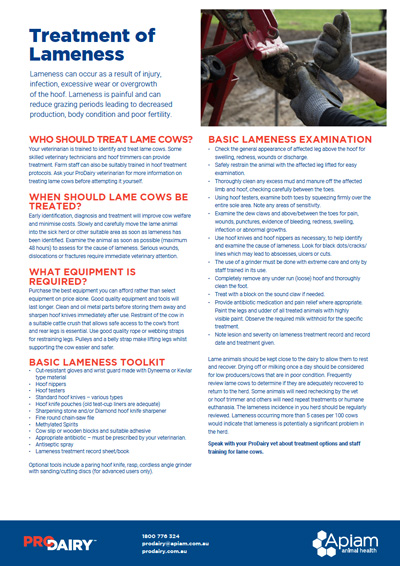Lameness can occur as a result of injury, infection, excessive wear or overgrowth of the hoof. Lameness is painful and can reduce grazing periods leading to decreased production, body condition and poor fertility.
WHO SHOULD TREAT LAME COWS?
Your veterinarian is trained to identify and treat lame cows. Some skilled veterinary technicians and hoof trimmers can provide treatment. Farm staff can also be suitably trained in hoof treatment protocols.
Ask your ProDairy veterinarian for more information on treating lame cows before attempting it yourself.
WHEN SHOULD LAME COWS BE TREATED?
Early identification, diagnosis and treatment will improve cow welfare and minimise costs. Slowly and carefully move the lame animal into the sick herd or other suitable area as soon as lameness has been identified.
Examine the animal as soon as possible (maximum 48 hours) to assess for the cause of lameness. Serious wounds, dislocations or fractures require immediate veterinary attention.

WHAT EQUIPMENT IS REQUIRED?
Purchase the best equipment you can afford rather than select equipment on price alone. Good quality equipment and tools will last longer. Clean and oil metal parts before storing them away and sharpen hoof knives immediately after use. Restraint of the cow in a suitable cattle crush that allows safe access to the cow’s front and rear legs is essential. Use good quality rope or webbing straps for restraining legs. Pulleys and a belly strap make lifting legs whilst supporting the cow easier and safer.
BASIC LAMENESS TOOLKIT
- Cut-resistant gloves and wrist guard made with Dyneema or Kevlar type material
- Hoof nippers
- Hoof testers
- Standard hoof knives – various types
- Hoof knife pouches (old teat-cup liners are adequate)
- Sharpening stone and/or Diamond hoof knife sharpener
- Fine round chain-saw file
- Methylated Spirits
- Cow slip or wooden blocks and suitable adhesive
- Appropriate antibiotic – must be prescribed by your veterinarian.
- Antiseptic spray
- Lameness treatment record sheet/book
Optional tools include a paring hoof knife, rasp, cordless angle grinder with sanding/cutting discs (for advanced users only).
BASIC LAMENESS EXAMINATION
- Check the general appearance of affected leg above the hoof for swelling, redness, wounds or discharge.
- Safely restrain the animal with the affected leg lifted for easy examination.
- Thoroughly clean any excess mud and manure off the affected limb and hoof, checking carefully between the toes.
- Using hoof testers, examine both toes by squeezing firmly over the entire sole area. Note any areas of sensitivity.
- Examine the dew claws and above/between the toes for pain, wounds, punctures, evidence of bleeding, redness, swelling, infection or abnormal growths.
- Use hoof knives and hoof nippers as necessary, to help identify and examine the cause of lameness. Look for black dots/cracks/ lines which may lead to abscesses, ulcers or cuts.
- The use of a grinder must be done with extreme care and only by staff trained in its use.
- Completely remove any under run (loose) hoof and thoroughly clean the foot.
- Treat with a block on the sound claw if needed.
- Provide antibiotic medication and pain relief where appropriate. Paint the legs and udder of all treated animals with highly visible paint. Observe the required milk withhold for the specific treatment.
- Note lesion and severity on lameness treatment record and record date and treatment given.
Lame animals should be kept close to the dairy to allow them to rest and recover. Drying off or milking once a day should be considered for low producers/cows that are in poor condition. Frequently review lame cows to determine if they are adequately recovered to return to the herd. Some animals will need rechecking by the vet or hoof trimmer and others will need repeat treatments or humane euthanasia. The lameness incidence in you herd should be regularly reviewed. Lameness occurring more than 5 cases per 100 cows would indicate that lameness is potentially a significant problem in the herd.
